 Roast goose was a traditional Christmas dish in France for many years, probably for centuries, but it is rather rare on holiday tables these days, having ceded its place to turkey, capon or duck. Nonetheless, roast goose is delicious. This year I decided to roast a goose well before Christmas in order to post it here in time for you to think about it, and perhaps make it. But getting the goose proved harder than anticipated. In fact it was a bit of a feat.
Roast goose was a traditional Christmas dish in France for many years, probably for centuries, but it is rather rare on holiday tables these days, having ceded its place to turkey, capon or duck. Nonetheless, roast goose is delicious. This year I decided to roast a goose well before Christmas in order to post it here in time for you to think about it, and perhaps make it. But getting the goose proved harder than anticipated. In fact it was a bit of a feat.
Oie rôtie de Noël / Roast Christmas goose
It all began in early December when I invited a few friends over for dinner the following Saturday, promising them roast goose. I set out to the local farmer’s market on a Sunday morning, six days ahead of time, hoping if not to find a goose at least to order one. My favorite poultry merchant, Monsieur Breton, had no geese on display. When I asked if he could get me one when the market reconvened on Thursday, he gave me a Gallic shrug.
The problem was not just that geese are raised in France to be ready for the market only in the week ahead of Christmas. There was also the matter of the gilets jaunes, the protesters demanding a living wage who have blocked roads and, joined by hooligans on Saturdays, wreaked havoc in France for the last few weeks. Monsieur Breton said that even if he could find a goose that was ready for the market, he couldn’t be sure he could get it. For the protesters have not only blocked roads, they have blockaded fuel depots, and gasoline supplies are uncertain throughout the country. Trucks aren’t delivering the goods.
‘Call me Wednesday,’ said Monsieur Breton, handing me his card. On Wednesday I called. ‘Call me Thursday,’ he said. I tried, but he didn’t answer. By this time I had called off the dinner party. In any event, a couple of guests had begged off, saying they were afraid to cross Paris on a Saturday night, what with angry people setting cars on fire and smashing windows throughout the city, and the police riposting with tear gas. But I still wanted to make the recipe for the site. So I texted him on Friday morning. Again, no reply.
Early Friday evening, I was minding my own business at home when my phone signaled that I had received a text. It was Monsieur Breton. ‘You can count on a goose on Sunday morning,’ he wrote. Well! I quickly rescheduled the dinner for the following Tuesday. Four people could make it, and a fifth wasn’t sure.
On Sunday morning, I took my time about getting to the market. It was raining hard, but eventually off I went. Arriving at Monsieur Breton’s stand, I peered at the poultry display. There I saw … half a goose. As Monsieur Breton was nowhere to be seen, I hailed his wife. ‘Excuse me,’ said I in dismay, ‘but where is the other half?’ Again, the Gallic shrug. ‘We sold it,’ she said. ‘But I ordered a whole goose,’ I protested. ‘Would you possibly have another?’ She looked around for her husband. He might have one, she said.
As she picked her phone to call him, I noticed the price of the partial goose, written in blue grease pencil on the pink wax paper beneath it. 54 euros! ‘Hold on a second,’ I said. ‘Is this the price of half a goose?’ She gave me a cool nod. Mais oui, madame. I made a quick calculation. ‘Does that mean a whole goose costs more than a hundred euros?’ (108 euros = $122). Mais oui. ‘Never mind,’ I said. ‘Half a goose will be fine.’
At that point, Monsieur Breton arrived on the scene. Along with the half a goose, he gave me half a liver, half a gizzard and half a neck. He also proposed half a heart, but I passed. The 9-pound bird would feed four or five, he said, and should roast for 2-1/4 hours.
I had my doubts about the cooking time, but had no doubt that I wanted my guests to have enough to eat. Not wishing to add another bird, I decided to make several side dishes — pear slices sautéed in butter, sautéed baby artichokes, stuffing and watercress salad — with braised fennel soup to start, and cheese and clémentines to finish. One of the guests brought a poppyseed Christmas cake she’d acquired in Berlin. No one went hungry.
I roasted the goose on the Tuesday morning — I couldn’t wait until dinnertime because my recipe photos need natural light. Early preparation turned out to be a great idea. I was able to carve the goose at my leisure and reheat it just before serving. In the end, the roasting time was 1-1/2 hours, perhaps because it was only half a goose.
 If you’ve never roasted a goose before, there are tips on the recipe page for ensuring that it stays tender and moist. In the next few days, I will update the Holiday Menus page with this recipe and others you may wish to consult for creating a festive occasion.
If you’ve never roasted a goose before, there are tips on the recipe page for ensuring that it stays tender and moist. In the next few days, I will update the Holiday Menus page with this recipe and others you may wish to consult for creating a festive occasion.
Happy cooking, and merry Christmas!
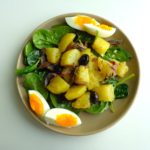 The other day a friend brought me a humble present — a jar of anchovies. But not just any anchovies. They were from Collioure, a picturesque fishing port on the French Mediterranean coast, which by some accounts produces the best anchovies in the world. I decided to try them out in a tangy salad of potatoes and black olives, set on a bed of baby spinach leaves, with mellow eggs on the side. The combination proved to be a knock-out.
The other day a friend brought me a humble present — a jar of anchovies. But not just any anchovies. They were from Collioure, a picturesque fishing port on the French Mediterranean coast, which by some accounts produces the best anchovies in the world. I decided to try them out in a tangy salad of potatoes and black olives, set on a bed of baby spinach leaves, with mellow eggs on the side. The combination proved to be a knock-out.
 Are French fries the ultimate French food? They may have been, but their quality in bistros has declined so much over the years that their enduring popularity here in France is a mystery. I would walk across Paris for good frites — crispy on the outside, meltingly tender on the inside — but they are not so easily found. There is another solution. Making your own fries is remarkably simple, and they are just as good as the delectable original.
Are French fries the ultimate French food? They may have been, but their quality in bistros has declined so much over the years that their enduring popularity here in France is a mystery. I would walk across Paris for good frites — crispy on the outside, meltingly tender on the inside — but they are not so easily found. There is another solution. Making your own fries is remarkably simple, and they are just as good as the delectable original. That time having passed, why not try making them at home? French fries marry well with many dishes on this site, among them all the omelets,
That time having passed, why not try making them at home? French fries marry well with many dishes on this site, among them all the omelets, 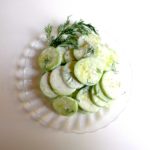 Simple starters are having a moment in Paris, and today I am featuring one of my favorites, cucumbers in cream. This tasty dish may be enhanced with the herb of your choice – cilantro, dill, chives or chervil – and served on its own, with another simple starter or two, as part of an
Simple starters are having a moment in Paris, and today I am featuring one of my favorites, cucumbers in cream. This tasty dish may be enhanced with the herb of your choice – cilantro, dill, chives or chervil – and served on its own, with another simple starter or two, as part of an 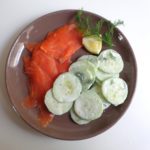 Returning to
Returning to  When the French are asked to name their favorite dishes, couscous invariably comes near the top of the list. And why not? This import from North Africa is delicious, economical and healthy. The fluffy semolina grain forms a bed for veggies and chick peas cooked in a rich broth flavored with mildly exotic spices. Then along comes your choice of meat, poultry, spicy sausage, fish or a combination, as in this ‘royal’ version.
When the French are asked to name their favorite dishes, couscous invariably comes near the top of the list. And why not? This import from North Africa is delicious, economical and healthy. The fluffy semolina grain forms a bed for veggies and chick peas cooked in a rich broth flavored with mildly exotic spices. Then along comes your choice of meat, poultry, spicy sausage, fish or a combination, as in this ‘royal’ version.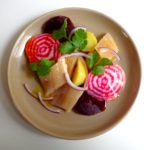 Smoked herring and potatoes bathed in a gentle vinaigrette is a classic French bistro starter. In this rendition, two types of beets are added to the plate — cooked red beets and raw, striped heirloom beets — along with onion and cilantro. I was inspired to prepare the dish this way after encountering it last winter at one of my favorite Paris bistros, Le Desnoyez, where presentation is an art form and the food is modern and delicious.
Smoked herring and potatoes bathed in a gentle vinaigrette is a classic French bistro starter. In this rendition, two types of beets are added to the plate — cooked red beets and raw, striped heirloom beets — along with onion and cilantro. I was inspired to prepare the dish this way after encountering it last winter at one of my favorite Paris bistros, Le Desnoyez, where presentation is an art form and the food is modern and delicious.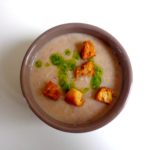 With the holidays behind us, it’s time for simpler fare. Rustic and wholesome, French white bean soup makes a fine January meal. Begin or follow with a salad, add some cheese and fruit, open a bottle of red and voilà. In this version, the soup is flavored with garlic, onion and rosemary. When I cooked up a pot of it on a recent gray Paris day, I topped the soup with a drizzle of herb-and-garlic infused olive oil and some freshly baked croutons.
With the holidays behind us, it’s time for simpler fare. Rustic and wholesome, French white bean soup makes a fine January meal. Begin or follow with a salad, add some cheese and fruit, open a bottle of red and voilà. In this version, the soup is flavored with garlic, onion and rosemary. When I cooked up a pot of it on a recent gray Paris day, I topped the soup with a drizzle of herb-and-garlic infused olive oil and some freshly baked croutons.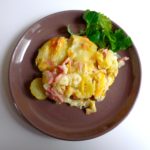 Tartiflette
Tartiflette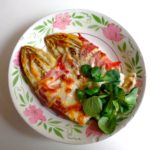 Endives gratinées au jambon de pays
Endives gratinées au jambon de pays Linzertorte is one of my favorite desserts, and when better to serve it than over the holidays? This classic cake, which takes its name from the Austrian town of Linz, is now enjoyed worldwide. The nutty shortbread-style pastry is filled with jam — typically black or red currant or plum — but in Alsace, where it is often served over the Christmas season, raspberry jam is preferred.
Linzertorte is one of my favorite desserts, and when better to serve it than over the holidays? This classic cake, which takes its name from the Austrian town of Linz, is now enjoyed worldwide. The nutty shortbread-style pastry is filled with jam — typically black or red currant or plum — but in Alsace, where it is often served over the Christmas season, raspberry jam is preferred. Roast goose was a traditional Christmas dish in France for many years, probably for centuries, but it is rather rare on holiday tables these days, having ceded its place to turkey, capon or duck. Nonetheless, roast goose is delicious. This year I decided to roast a goose well before Christmas in order to post it here in time for you to think about it, and perhaps make it. But getting the goose proved harder than anticipated. In fact it was a bit of a feat.
Roast goose was a traditional Christmas dish in France for many years, probably for centuries, but it is rather rare on holiday tables these days, having ceded its place to turkey, capon or duck. Nonetheless, roast goose is delicious. This year I decided to roast a goose well before Christmas in order to post it here in time for you to think about it, and perhaps make it. But getting the goose proved harder than anticipated. In fact it was a bit of a feat. If you’ve never roasted a goose before, there are tips on the
If you’ve never roasted a goose before, there are tips on the  This is a versatile salad featuring two types of greens that come into their own in late autumn and winter: mâche (aka lamb’s lettuce) and Belgian endive. Mustardy vinaigrette sauce and plenty of garlic turn the leaves into a zesty salad that may be served as is or enhanced with walnuts, Alpine cheese and/or country ham. This adaptability will allow you to enjoy it whatever your culinary proclivity — omnivore, vegetarian or vegan.
This is a versatile salad featuring two types of greens that come into their own in late autumn and winter: mâche (aka lamb’s lettuce) and Belgian endive. Mustardy vinaigrette sauce and plenty of garlic turn the leaves into a zesty salad that may be served as is or enhanced with walnuts, Alpine cheese and/or country ham. This adaptability will allow you to enjoy it whatever your culinary proclivity — omnivore, vegetarian or vegan. While either mâche and Belgian endive may be served on its own as salad, they pair nicely and can form the basis for a quickly prepared and tasty salad at lunchtime, with or without extra ingredients, or a salad course to precede or follow a main dish. The garlic adds zing, as does the homemade mustard vinaigrette, a French classic that also harks back to days of yore.
While either mâche and Belgian endive may be served on its own as salad, they pair nicely and can form the basis for a quickly prepared and tasty salad at lunchtime, with or without extra ingredients, or a salad course to precede or follow a main dish. The garlic adds zing, as does the homemade mustard vinaigrette, a French classic that also harks back to days of yore.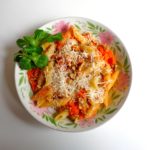 This dish gives an interesting twist to pumpkin that may be of interest as the holidays approach. Yes, I’m thinking Thanksgiving. The combination of pasta and pumpkin is popular in both France and Italy, and the walnuts add depth. This version also has a touch of Meg thanks to the spicing — not nutmeg, as my childhood friends delighted in calling me, but cumin which, combined with a spritz of lemon juice, adds a welcome zest.
This dish gives an interesting twist to pumpkin that may be of interest as the holidays approach. Yes, I’m thinking Thanksgiving. The combination of pasta and pumpkin is popular in both France and Italy, and the walnuts add depth. This version also has a touch of Meg thanks to the spicing — not nutmeg, as my childhood friends delighted in calling me, but cumin which, combined with a spritz of lemon juice, adds a welcome zest.

